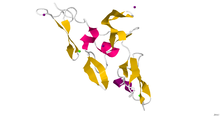Fibrillin-1
Fibrillin-1 is a major component of the microfibrils that form a sheath surrounding the amorphous elastin. It is believed that the microfibrils are composed of end-to-end polymers of fibrillin. To date, 3 forms of fibrillin have been described. The fibrillin-1 protein was isolated by Engvall in 1986, [5] and mutations in the FBN1 gene cause Marfan syndrome. [6] [7]
This protein is found in humans, and its gene is found on chromosome 15. At present more than 1500 different mutations have been described. [1] [7]
Structure
There is no complete, high-resolution structure of fibrillin-1. Instead, short fragments have been produced recombinantly and their structures solved by X-ray crystallography or using NMR spectroscopy. A recent example is the structure of the fibrillin-1 hybrid2 domain, in context of its flanking calcium binding epidermal growth factor domains, which was determined using X-ray crystallography to a resolution of 1.8 Å. [1] The microfibrils that are made up of fibrillin protein are responsible for different cell-matrix interactions in the human body.
